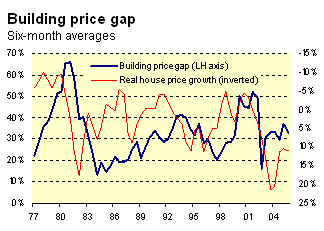Turn up the volume
There has been a trend towards volume builders over the last decade — an increased number of larger firms expanding market share at the expense of small building companies. A similar trend has been evident in other areas of business — supermarkets and department stores, for example. We believe the trend towards volume builders has further to go, with tighter regulations and the desire to keep building costs down both factors that will give larger players an advantage over their smaller rivals.
Squeezing out the little guys
In the year to March 1997, there were only six construction firms with over 100 new dwelling consents (excluding apartments), accounting for 6.9% of the total residential building market. By 2006, that number had risen to 17 firms with 18% of the total market share.
Graph 1.1 shows total market shares for different size building firms over the last ten years.[1] While the proportion of total construction work undertaken by builders of 80 or more dwellings per annum has risen, almost all other segments of the market have shrunk (the exceptions are owner builders and builders of 40-79 dwellings per annum, both of which have been flat).

Graph 1.1
The residential building sector has gone through 2 ½ cycles since 1997. The larger firms have tended to hold their own(in terms of market share) during the downturns, and expanded their market share during the upturns. Large established firms are able to lift their production relatively quickly in response to increasing demand, so it is unsurprising that they reap the benefits of a building boom.
Over time, this trend squeezes the smaller players out of the market. The number of construction firms building three or four new houses per annum has fallen from 559 in 1997 to 444 this year(despite a higher overall level of building activity for the last 12 months than in the year to March 1997). Table 1.1 shows the ten biggest residential construction firms in 1997, 2001, and 2006.

Table 1.1
Figures from the Housing Industry Association in Australia show that in 2002/03, the 100 largest construction firms built around 45% of all new detached houses. By comparison, the market share accounted for by the 100 largest firms in New Zealand in 2005/06 was 32% (up from 22% in 1997). The biggest Australian company, the Alcock/Brown-Neaves Group, enjoyed a 2.5% market share, which is similar to the size of the largest firm in New Zealand.
Keeping costs down
Graph 1.2 shows the gap between average new dwelling consent values and average improvement values (hereafter referred to as the building price gap) over the last 30 years.[2] During that period, building a new house has always been more expensive than buying an existing property (excluding the land cost). It cost 14% more to build a new house than buy an existing property in 1984, and a whopping 66% more in 1981. If builders can keep their costs down, it helps reduce the building price gap.
Graph 1.2 also reveals a loose relationship between house price inflation and the building price gap — when real house price inflation is strong (e.g. 1981-2), the building price gap shrinks. The reverse is true when real house price inflation is weak. The house price boom since 2003 has reduced the building price gap, but perhaps not by as much as might have been expected. With the building price gap still at around 33%, the implication is that the gap could become quite large over the next few years as the housing market goes through a slow patch.
A continuation of the trend towards volumes builders over the next five years could help limit the expansion in the building price gap. There are two cost-associated reasons for ongoing growth in the number of volume builders.

Graph 1.2
The first factor relates to material costs. Building a large number of dwellings simultaneously implies the need for large quantities of fixtures and fittings. A firm purchasing 250 door handles at once, rather than ten, will presumably be able to negotiate amore favourable price with suppliers, and pass some of those savings on to its customers. In dealing with larger quantities, there is even scope to import the products directly and cut out the costs of the middleman. The ability of volume builders to keep material costs down has probably been one of the main factors behind their growth over the last decade.
The second reason is the increased level of regulation of the building industry. The need for all building work to be overseen by a licensed builder will push up the labour cost associated with construction. For a small building firm with three workers, for example, the percentage cost increase will be much larger than for a firm with 50 employees, where the licensed builder will be able to spread his increased cost of supervision over a large number of projects. Thus the increased compliance costs will tend to work against smaller building firms.

















